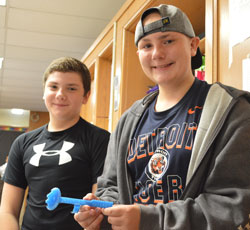Seventh grader Annabelle Kopenkosky has no desire to become a design engineer, but she is finding the new 3D design class useful for her intended career in interior design. “I love moving furniture around and figuring out what should go where,” she said.
For many students, including Annabelle, the class — made possible by Sparta Education Foundation’s purchase of a 3D printer for the middle school — isn’t just for fun; it is teaching real life skills.
“The need for skills like these (in design) is becoming more and more prevalent in today’s society,” teacher Ericka McKellar said.
Added seventh grader Nolan Larson: “It would be better if we could have a metal printer, because we can’t really make anything useful, but learning actual design, I feel, is worthwhile.”

How it Works
Students utilize free online software tools, including Tinkercad and Sketchup to create projects, according to McKellar. “We have used them both in a variety of ways to create different things. We started our year out with Tinkercad as it is easier to get the hang of and manipulate shapes and create objects,” she said. “We then moved on, and the students have created things with real-world textures and ideas.”
Because it is a new class and concept for the school, McKellar said she and her students are still exploring which programs are available and those they prefer. After only a couple of months in class, students choose which programs they want to use “depending on their needs for a certain project,” she said. “These kids shock me every day what they can do with their Chromebooks.”
There have been a few challenges, and McKellar said the class is still a learning process both for her and for students. She learned quickly that size of items being designed makes a difference. “With some projects, the estimated print time would be about nine hours,” she said. “With 33 students in the class, that wasn’t realistic.”

Maximum Engagement
Designing a tiny house model was a favorite assignment. “It was fun trying to figure out where to put everything you needed,” said Isaiah Dekubber, who admits he might like to try living in one. “There are lots of good ideas for them, and I think it is cool that people actually use them.”
Another popular assignment was a pirate ship playground design. Annabelle said it was her favorite because “I actually learned to put on a roof, and I am looking forward to doing more with buildings.”
Personal creations utilizing the 3D printer also stood out.
Makaylah Jackson and Emma Pollice worked together to make a case for a cell phone. “It was pretty successful,” said Makaylah, “but we need to work on the details a bit more, so it actually fits the phone,” added Emma.
Determining size was also an issue for Kayden Wilk, who designed rings for his mother and father. “They look smaller than I thought they would be,” he said as he watched the printer do its job.
Belzar Roblero showed off a hand-held cord holder complete with a push button meant to make the cord retractable.
Ryan Gramza and Korey Pinckey created a universal camping utensil — named the spifestraw — with a knife, fork, spoon and straw holder.

Mallory Weronko designed a universal container that “could hold anything,” she explained.
Sawyer Werkema and Travis Shuker both hope to pursue careers in design and say they find the course fascinating. The pair took the tiny house assignment to a new level, and designed a vehicle and tiny house in one with a distinct purpose: hunting. They showed off inside compartments designed to hold equipment, and outside bins for other essentials such as a chainsaw.
“Some of it is so meaningful to them,” McKellar said. “I am constantly amazed at the level of detail put into these projects. I am going to try this next in a sixth grade class and am super excited to see what’s next.”













